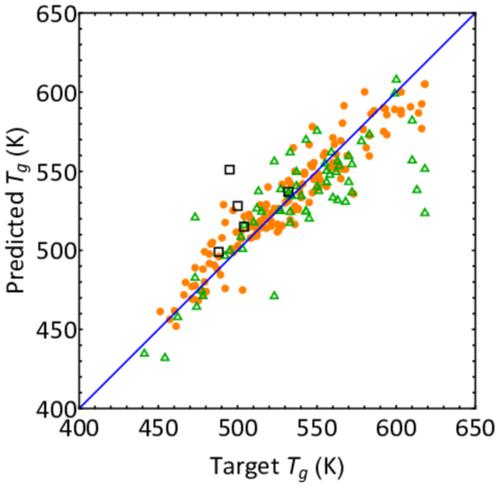当前位置:
X-MOL 学术
›
J. Polym. Sci.
›
论文详情
Our official English website, www.x-mol.net, welcomes your
feedback! (Note: you will need to create a separate account there.)
Determination of glass transition temperature of polyimides from atomistic molecular dynamics simulations and machine-learning algorithms
Journal of Polymer Science ( IF 3.9 ) Pub Date : 2020-04-13 , DOI: 10.1002/pol.20200050 Chengyuan Wen 1, 2 , Binghan Liu 1, 2 , Josh Wolfgang 2, 3 , Timothy E. Long 2, 3 , Roy Odle 4 , Shengfeng Cheng 1, 2, 5
Journal of Polymer Science ( IF 3.9 ) Pub Date : 2020-04-13 , DOI: 10.1002/pol.20200050 Chengyuan Wen 1, 2 , Binghan Liu 1, 2 , Josh Wolfgang 2, 3 , Timothy E. Long 2, 3 , Roy Odle 4 , Shengfeng Cheng 1, 2, 5
Affiliation

|
Glass transition temperature ($T_{\text{g}}$) plays an important role in controlling the mechanical and thermal properties of a polymer. Polyimides are an important category of polymers with wide applications because of their superior heat resistance and mechanical strength. The capability of predicting $T_{\text{g}}$ for a polyimide $a~priori$ is therefore highly desirable in order to expedite the design and discovery of new polyimide polymers with targeted properties and applications. Here we explore three different approaches to either compute $T_{\text{g}}$ for a polyimide via all-atom molecular dynamics (MD) simulations or predict $T_{\text{g}}$ via a mathematical model generated by using machine-learning algorithms to analyze existing data collected from literature. Our simulations reveal that $T_{\text{g}}$ can be determined from examining the diffusion coefficient of simple gas molecules in a polyimide as a function of temperature and the results are comparable to those derived from data on polymer density versus temperature and actually closer to the available experimental data. Furthermore, the predictive model of $T_{\text{g}}$ derived with machine-learning algorithms can be used to estimate $T_{\text{g}}$ successfully within an uncertainty of about 20 degrees, even for polyimides yet to be synthesized experimentally.
中文翻译:

通过原子分子动力学模拟和机器学习算法确定聚酰亚胺的玻璃化转变温度
玻璃化转变温度 ($T_{\text{g}}$) 在控制聚合物的机械和热性能方面起着重要作用。聚酰亚胺因其优异的耐热性和机械强度而成为应用广泛的一类重要聚合物。因此,非常需要预测聚酰亚胺 $a~priori$ 的 $T_{\text{g}}$ 的能力,以加快具有目标特性和应用的新型聚酰亚胺聚合物的设计和发现。在这里,我们探索了三种不同的方法来通过全原子分子动力学 (MD) 模拟计算聚酰亚胺的 $T_{\text{g}}$ 或通过由以下生成的数学模型预测 $T_{\text{g}}$使用机器学习算法分析从文献中收集的现有数据。我们的模拟表明 $T_{\text{g}}$ 可以通过检查聚酰亚胺中简单气体分子的扩散系数作为温度的函数来确定,结果与聚合物密度与温度和实际上更接近可用的实验数据。此外,使用机器学习算法推导出的 $T_{\text{g}}$ 预测模型可用于在大约 20 度的不确定度内成功估计 $T_{\text{g}}$,即使对于聚酰亚胺可以通过实验合成。
更新日期:2020-04-13
中文翻译:

通过原子分子动力学模拟和机器学习算法确定聚酰亚胺的玻璃化转变温度
玻璃化转变温度 ($T_{\text{g}}$) 在控制聚合物的机械和热性能方面起着重要作用。聚酰亚胺因其优异的耐热性和机械强度而成为应用广泛的一类重要聚合物。因此,非常需要预测聚酰亚胺 $a~priori$ 的 $T_{\text{g}}$ 的能力,以加快具有目标特性和应用的新型聚酰亚胺聚合物的设计和发现。在这里,我们探索了三种不同的方法来通过全原子分子动力学 (MD) 模拟计算聚酰亚胺的 $T_{\text{g}}$ 或通过由以下生成的数学模型预测 $T_{\text{g}}$使用机器学习算法分析从文献中收集的现有数据。我们的模拟表明 $T_{\text{g}}$ 可以通过检查聚酰亚胺中简单气体分子的扩散系数作为温度的函数来确定,结果与聚合物密度与温度和实际上更接近可用的实验数据。此外,使用机器学习算法推导出的 $T_{\text{g}}$ 预测模型可用于在大约 20 度的不确定度内成功估计 $T_{\text{g}}$,即使对于聚酰亚胺可以通过实验合成。











































 京公网安备 11010802027423号
京公网安备 11010802027423号